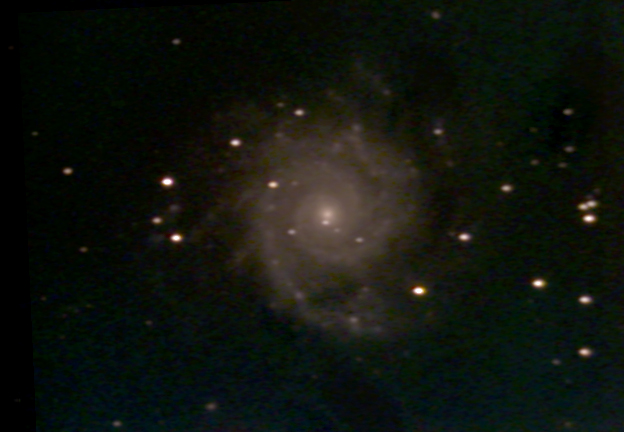
M74

RA: 01hr 36m 42s Dec: 15º 47' 00", Mag: 9.4 Distance: 35 million light-years Constellation: Pisces
M74, invisible even through my 8" SCT on a misty night, is visualised on long exposure CCD. Discovered by Méchain in September 1780, it has low surface brightness and is challenging to spot through an eyepiece, even through large telescopes. In January 2002, a supernova exploded in the lower dangling arm, between the two glowing 'knots' visible in the picture. SN 2002ap achieved a peak magnitude of 12.3 but cannot be distinguished in the low resolution of this picture. It was later found to be a type 1 hypernova, resulting from the explosion of a star 40 times the mass of our sun.
This picture was taken on the 1st November 2006 with the moon lighting up the sky in the beginning of its second quarter, gibbous phase. There was mist in the air and the temperature was 6.5°C. This picture is a combination of 4 exposures made by Envisage from 30 second stacks as follows, 18x30, 23x30, 31x30 and 32x30, thus giving a cumulative exposure time of 52 minutes. Once again, I was working with an initial image with a less than optimal signal-to-noise ratio, largely as a result of the mist in the air catching the light of the moon as well as the wasteful and environmentally-shocking white floodlights of the nearby recreation park. In order to be able to enhance the midtones without increasing the background noise as well, a positive layer mask was made in which the objects of interest were 'whited-out' with a degree of feathering achieved by using Gaussian blur, and the background darkened in the areas where it was bright, using the 'Burn Tool'. Any lightening of the background, therefore, during midtone enhancement, was masked by the black areas of the layer mask applied on top of it. No changes were made in either the curves or levels command in the individual colour channels, so the relative ratios of RGB were preserved as captured.
HOME PICTURES: Deep Sky PICTURES: Solar system PICTURES: Wide field